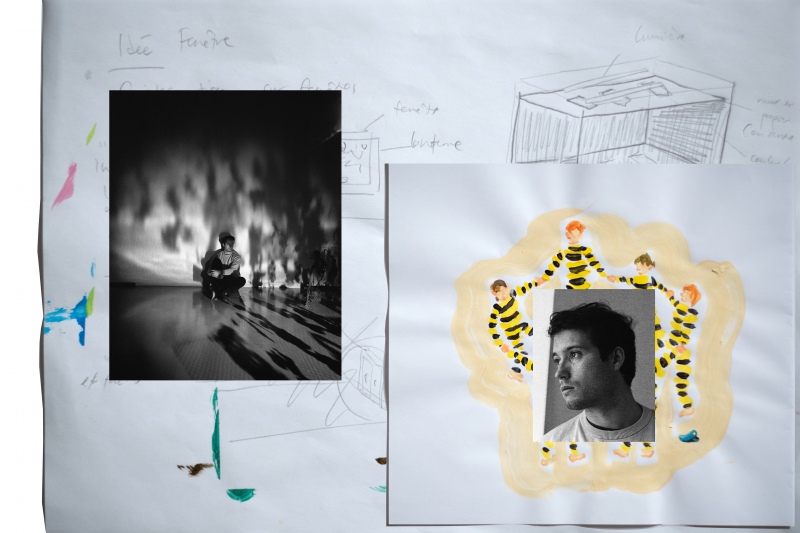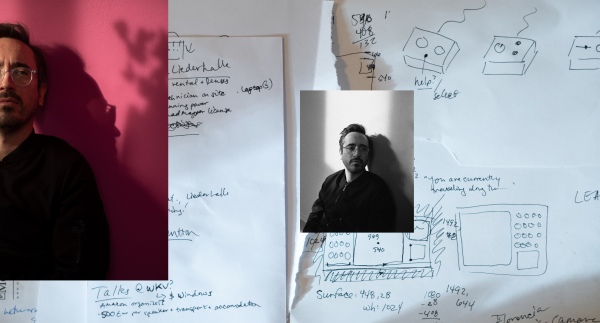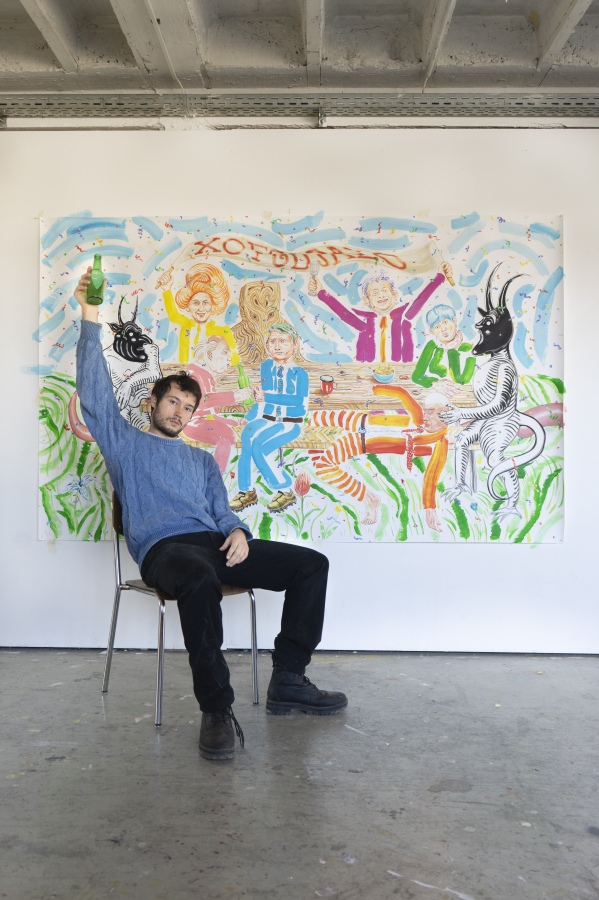Exploring the carnivalesque
Paul Hutzli in conversation with Klara Czerniewska-Andryszczyk
-
I have the impression that your work could come under the current trends of new surrealism and new expressionism in the visual arts. Would that suit you?
- Surrealism and expressionism are definitely things I like, and I think my drawing style could be described like this. On the other hand, these are just historic references to modernist movements, and I believe my practice deals with different processes: there will always be research and I'm always going to be reading something. In the first step of my artistic investigation, I experiment with forms, colours, materials and create drawings, which in this phase are very spontaneous – perhaps this is where the expressionist or surrealist aspect arises.
-
What have you been researching so far?
- The widest research I have ever conducted was during my Master’s, when I wrote about the carnival. I was inspired by the Carnival of Basel and was interested in the notion of aesthetics and politics, which is also what I am studying here.
-
Carnivals are subversive, they are said to question the status quo. They also happen outside, in public space – same as public demonstrations or street art...
- Yes, exactly. I am interested in that chaos, which for me represents a desire for freedom – of course knowing that there is no total freedom: freedom is the selection of choices you have. I am interested in the tension between this chaos and the institutional framework, the rules and conventions of carnival. I could talk about it for hours.
-
Going back to the material side of your work, you often use artisanal materials, such as sugar or papier-mâché – which again redirects us to the carnivalesque, because people make masks with it...
- One of the most interesting things I did with it was sculptures of chairs. I first made a papier-mâché chair five years ago, during my studies. I didn't know what to do with it back then. I didn't see why it would be interesting to anyone, so I just tossed it away. Later, when I started teaching visual arts at school, I noticed that the chairs I had made looked a lot like the chairs that were in classrooms. I realised that I could find them basically in almost every place where I was being educated: at school, university and even in the military. This stiff, steel and plywood chair is something that disciplines people to sit and behave in a certain way. I realised that it is a tool of control – and people don't like being controlled. That’s why students have always appropriated their chairs by drawing or engraving on them, putting stickers or chewing gum. I tried to envision this reactionary aspect in my series of papier mâché chairs, which were slightly bent and obviously very fragile. I also made a chewing gum portrait of President Macron on one of them (laughs).
-
There's a lot of transgression in your works – you tend to mix highbrow and lowbrow aspects of culture, e.g. playing with the hyperrealist trompe-l’oeil technique. Are you interested in pop culture?
- People often ask me about pop art, but I don't feel close to Andy Warhol or any other artist of that genre. I would rather refer to the vernacular. On the other hand, the chair series is accompanied by a rap song that I wrote and performed, with music written by a friend of mine who I met in the military.
-
Military service is obligatory in Switzerland. Did it enforce your ability to be self-disciplined?
- Maybe... it’s interesting, because this brings us back to the topic of school and me being a teacher. I teach adolescents, who really aren’t very keen on being there. It took me a while to understand how difficult it is for them. School is very violent; it's just like the military. Schooling is a way to prepare kids for society as it is. But our society is problematic on a lot of levels. It is a big question for me, which is why I’m also very happy to be doing this residency. It means that this year I can focus on my practice, as I won’t be teaching. I have been given the time to take a step back.
-
How did you happen to get the residency at the Castle?
- I first came here to visit a friend, Rémi Dufay, who was on this residency last year. We are very good friends and collaborate often. This is how I met the people from the residencies the Castle and learned about the programme, which looked amazing. Rémi also contributed my drawings to the pocket calendar issued by the Castle – he took the drawings I did for another project we collaborated on, which we never received any funding for. I think the people from the residency programme came to know me through this, and then I wrote to tell them I was interested in coming here.
-
Can you tell me more about your inspirations, the artists, thinkers or tendencies you look up to?
- I am interested in anthropology for its notion of rituals, which was very trendy at some point. During this residency, I am studying the Frankfurt School: Adorno, Benjamin, Horkheimer and Marcuse. Institutional critique is also very important to me: Andrea Fraser, Michael Asher... I also really love the work of Jenny Holzer, although my work does not resemble anything like it. Another artist I love, who may be closer to what I do, would be Jeremy Deller. Just like him, I am interested in questioning the power of an artist’s name: in a performance called A very critical session, I aimed to invert the roles of the master and student: I announced that a famous Geneva-based artist would come to my end-of-semester evaluation session, and then had him played by a friend of mine wearing a carnivalesque, papier- mâché head...
-
I wanted to ask you about your latest exhibition: Candy Island, in which you created a fairy-tale like environment using stained glass landscapes and animalist sculptures made of sugar. Is the aspect of the childlike important to you?
- This is something I think has always been there in my work, but I have never acknowledged it. Perhaps this was because I felt it made my work look less critical. In Candy Island, I didn't necessarily think of children, but I see your point: having a space made of sugar makes you think of Hansel and Gretel.
-
The space worked as a kind of scenography, which made me think of the décor of public kindergartens... There were also plenty of birds there – why was that?
- This was because the space was inspired by an island in Geneva called L’Ile Rousseau, which used to be a military fort protecting the city, and now is a refuge for birds, right in the middle of the town. From there you can see the cityscape, full of logos of companies: Rolex, BNP Paribas, etc. I constructed the space in a way that it resembles a publicity lightbox, and at the same time created a simulation of daylight – the illusion that one has in the supermarkets, for example. There is a tension created by this artificiality. In fact, the first exhibition I did was also a bit like this – it was a white, paper mâché cube, resembling a lantern used in the Carnival of Basel. When you entered it, you had an immersive experience characteristic of the white cube experience, with the artworks inside.
-
I wanted to ask you about your relationship to the art market. Do you see yourself represented by a commercial art gallery, or are you rather focused on large commissions from public institutions? How do you see your future in the art world?
- That’s a good question, because I think you always change your mind depending on how much success you have. For me right now, I am lucky because I have not had too much success and I can act very consciously. I would basically like to stay like this as long as possible. Maybe one day I’ll find a gallery as well, but I think if I stay like this, I’m happy.
- Warsaw, 20 October 2021


